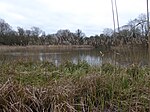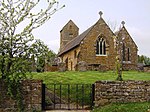Lower Boddington

Lower Boddington is a village and former civil parish, now in the parish of Boddington, in the West Northamptonshire district, in the ceremonial county of Northamptonshire, England. Lower Boddington is the smaller of the two villages in Boddington parish, most of whose facilities are located in Upper Boddington. It is about 8.5 miles (13.7 km) southwest of Daventry. In 1931 the parish had a population of 127. On 1 April 1935 the parish was abolished and merged with Upper Boddington to form "Boddington".The villages name means 'Bota's hill'.Children from Lower Boddington are most likely to attend a primary school in Aston le Walls, Chipping Warden, Leamington Spa or Upper Boddington. Teenagers are likely to attend Chenderit School, Southam College, Princethorpe College or Blesséd George Napier RC School in nearby Banbury. Lower Boddington has a public house, the Carpenters Arms, owned by the Hook Norton Brewery.
Excerpt from the Wikipedia article Lower Boddington (License: CC BY-SA 3.0, Authors, Images).Lower Boddington
Hill Road,
Geographical coordinates (GPS) Address Nearby Places Show on map
Geographical coordinates (GPS)
| Latitude | Longitude |
|---|---|
| N 52.168 ° | E -1.299 ° |
Address
Hill Road
Hill Road
NN11 6YB , Boddington
England, United Kingdom
Open on Google Maps






